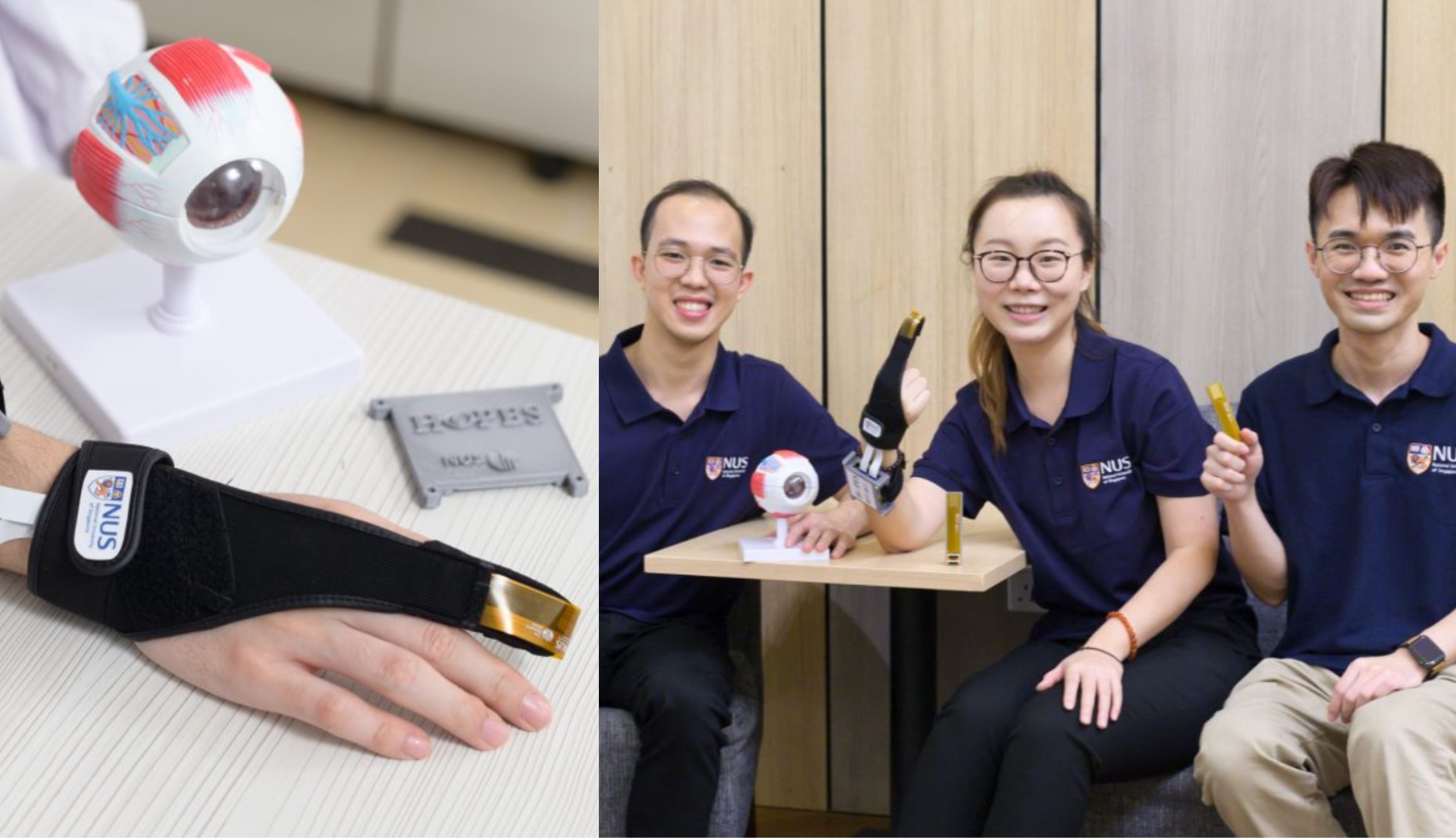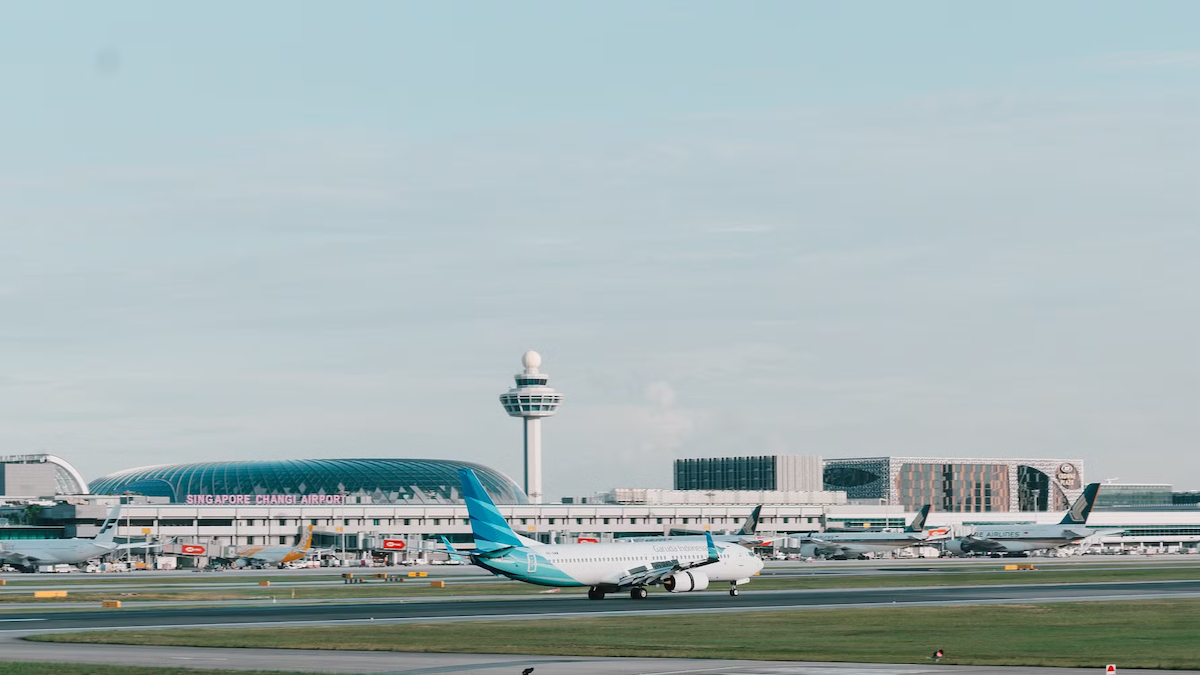Twenty-six-year-old Yu Kelu’s father was diagnosed with Glaucoma in late 2019.
Her father – 55-years-old – suffers from constant eye pain and headaches, as he has to visit the doctor for eye pressure tests and the pain usually lasts for days.
The pandemic also makes it a hassle to visit hospitals frequently, exposing themselves to viruses, on top of the uncomfortable treatment process. This made Kelu want to do something about it.
Kelu is a PhD student under the Department of Materials Science & Engineering at the National University of Singapore (NUS).

Through the school, she then roped in two other students – 26-year-old David Lee and 28-year-old Li Si. It was a melting pot of ideas, as all three of them have different educational backgrounds, and each tapped on their individual expertise to come up with a solution.
Si is a PhD student under the school’s Institute for Health Innovation & Technology while David is a research engineer with the school’s Department of Materials Science & Engineering.
The three young inventors combined their knowledge of materials, electronics, and machine learning to build an eye-tracking sensor device to detect Glaucoma, hoping that it can help people with these conditions improve their life.
They decided to call it HOPES, a ring in the name to symbolize a dream to help prevent the elderly from going blind.
The concept worked, and today (Nov 17) they were announced as the first Singapore International Winner for the James Dyson Award, bagging the top prize of S$53,000 to help them further their invention.
These Singapore winners – the first Singapore team in all 17 years of the award’s history – beat over 2,000 global entries to win the top prize, and they were personally selected by Sir James Dyson himself.
What is Glaucoma
Glaucoma is a prevalent disease amongst the middle-aged and the elderly, and is the leading cause of irreversible blindness worldwide.
Last year, about 80 million people in the world were diagnosed to have Glaucoma.
In Singapore, about three per cent of people over the age of 50 have this condition. Almost one out of 10 people over the age of 70 have Glaucoma.
Because it is largely symptom-free, it’s also known as the “silent thief of sight”. There’s no cure but if diagnosed and treated early, blindness can be prevented.

“Many sufferers overlook the consequences of increased eye pressure and may not notice any problems before their vision is lost,” shared Kelu, David, and Si in an interview with Vulcan Post.
“Hence, regular monitoring of eye pressure is necessary for early prevention and diagnosis of Glaucoma. Regular eye pressure check-ups can help slow or prevent vision loss, especially if one detects the disease in its early stages,” they said.
Current methods to inspect eye pressure require patients to visit the hospital every two to three hours over a 24-hour period to monitor fluctuations in eye pressure.
Sometimes, hospitalisation is required, which is disruptive to the patients’ everyday lives.

“Because of the inconvenience, many patients do not adhere to their schedules for check-ups. Therefore, we saw a need for an at-home intraocular pressure monitoring for Glaucoma management,” the team said.
The creation of HOPES
Last year, Kelu and Si met with ophthalmology specialist clinician Dr Victor Koh at the National University Hospital (NUH) to understand more about the problems of Glaucoma treatment and diagnosis.
Kelu and Si decided to design a wearable device that could leverage their knowledge and expertise in electronic-skin (e-skin) and sensor technology developed at Tee Research Group to measure eye pressure. Later, David joined the team to assist with the work.
Over the past 18 months, the team spent most of their waking hours designing, ideating, and prototyping HOPES. They hoped to fill a gap they identified in Glaucoma management – the need for a safe, non-invasive, low-cost, at-home eye pressure sensor.

Such a device can potentially be implemented with a telemedicine platform, reducing hospital visits and the burden on healthcare infrastructure, especially during the pandemic.
HOPES will also allow clinicians to use the data captured to adapt treatment plans. The team intends to make HOPES cater to many users, via a portable and accessible user experience.
After almost a hundred iterations of the product, HOPES was born – a wearable biomedical device for pain-free, low-cost, at-home intraocular pressure (IOP) testing. Powered by patent-pending sensor technology and artificial intelligence (AI), it is a convenient device for users – particularly Glaucoma sufferers – to self-monitor their IOP.
Early this year, the students’ supervisor Dr Benjamin Tee shared a newsletter about the James Dyson Award.
The team realised that the work they were doing aligned with the purpose of the award: To design an engineering solution to a problem.
Spurred by the alignment of vision, and with the hope that their product can make a difference and be recognised as one that can, the young researchers decided to submit HOPES for the award.

To their delight, they beat 2,000 entrants to emerge as the top winner for this international award, validating their research and showing them that it has the potential to solve problems in the real world.
How does the device work?
After creating a profile in the product app, the user wears the HOPES glove with the sensor placed at the fingertip, pressing this against the centre of the eyelid.
The fingertip employs a unique sensor architecture that captures dynamic pressure information of the user’s eye with sub-millisecond precision.
The captured signals are processed by machine learning algorithms to continuously and accurately compute users’ eye pressure scans.
Data is transmitted via Bluetooth to paired devices or uploaded to the Cloud to be accessed remotely by clinicians.

The app prompts users with easy-to-read measurement history and direct links to healthcare systems, allowing them to seek medical help to minimise future symptoms.
Beyond the simple and easy-to-use application, HOPES contains AI tech.
The team explained why AI is necessary for the product: “When discussing the problem of Glaucoma treatment with clinicians and conducting trials of our own, we noticed that eye pressure measurement becomes more challenging when the patient has had some prior injuries to the eye, such as scarring or lesions.”

“This, in addition to differences between patients’ eyelid textures, added additional complexities to our approach of measuring patients’ eye pressures. Hence, we decided to implement AI to help solve the problem of measuring the patient’s eye pressure while accounting for the variations in different patient conditions,” they said.
What’s next for HOPES
After finding out that HOPES bagged the James Dyson Award, the team has been approached by a few companies and venture firms both locally and overseas who want to know more about their invention.
“It was a pleasant surprise and this offers exciting opportunities. We are open to discussions about how we can take HOPES further and make it a reality,” the team said.
The students also have plans to collaborate with clinicians at NUH to collect and analyse patients’ eye pressure data to train the device’s machine learning mode.
They are currently focusing on optimising HOPES’ performance, improving its design, and working with local hospitals in Singapore to pilot HOPES soon.
On winning the James Dyson Award International Prize, the team said, “With this win, we hope in the future people can measure their eye pressure in a pain-free, at-home environment. We want to improve people’s quality of life and aspire to one day apply our research group’s sensor technology across different health monitoring applications, such as robotics and biomedical devices.”

Commenting on the Singapore win, Sir James Dyson, Founder and Chief Engineer at Dyson said, “I’ve experienced first-hand how invasive and unpleasant the tests for glaucoma can be, but it is a vital test.”
“This group of young people has tackled a problem that doesn’t affect them directly, but which affects members of their family. Their work has the potential to make Glaucoma testing much more widely available and I wish them every success as they navigate the challenging process of further development and medical approvals,” James said.
The James Dyson Award is administered and run by the James Dyson Foundation – an international charity that aims to nurture and inspire a new generation of design engineers and inventors.
Dyson as the business is not involved in the administration of the James Dyson Award and does not engage in recruitment, research, or the further development of students’ inventions, Dyson said in a response to queries.
“Participants retain absolute ownership of any intellectual property surrounding their ideas. The fullest support from the award comes in the form of media exposure, and the sharing of external contacts that may help support their journey to commercialisation,” it added.
Featured Image Credit: James Dyson Award, NUS








